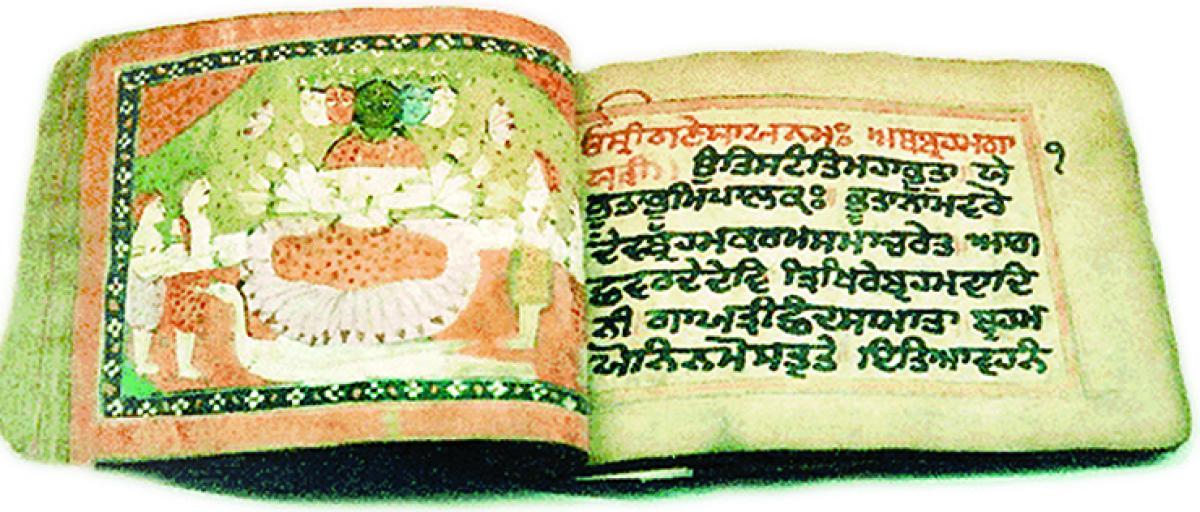Vedic philosophy

Religion of the Rig Vedic people was very simple in the sense that it consisted mainly of worship of numerous deities representing the various phenomena of nature through prayers. It was during the later Vedic period that definite ideas and philosophies about the true nature of soul or Atman and the cosmic principle or Brahman who represented the ultimate reality were developed.
Religion of the Rig Vedic people was very simple in the sense that it consisted mainly of worship of numerous deities representing the various phenomena of nature through prayers. It was during the later Vedic period that definite ideas and philosophies about the true nature of soul or Atman and the cosmic principle or Brahman who represented the ultimate reality were developed.
.jpg)
These Vedic philosophical concepts later on gave rise to six different schools of philosophies called shada darshana. They fall in the category of the orthodox system as the final authority of the Vedas is recognised by all of them. Let us now find out more about these six schools of Indian philosophy.
Samkhya System
The Samkhya philosophy holds that reality is constituted of two principles one female and the other male i.e. Prakriti, Purusha respectively. Prakriti and Purusha are completely independent and absolute. According to this system, Purusha is mere consciousness, hence it cannot be modified or changed.
Prakriti on the other hand is constituted of three attributes, thought, movement and the change or transformation of these attributes brings about the change in all objects. The Samkhya philosophy tries to establish some relationship between Purusha and Prakriti for explaining the creation of the universe. The propounder of this philosophy was Kapila, who wrote the Samkhya sutra.
Infact Samkhya school explained the phenomena of the doctrine of evolution and answered all the questions aroused by the thinkers of those days.
Yoga
Yoga literally means the union of the two principal entities. The origin of yoga is found in the Yogasutra of Patanjali believed to have been written in the second century BC. By purifying and controlling changes in the mental mechanism, yoga systematically brings about the release of purusha from prakriti. Yogic techniques control the body, mind and sense organs.
Thus this philosophy is also considered a means of achieving freedom or mukti. This freedom could be attained by practising self-control (yama), observation of rules (niyama), fixed postures (asana), breath control (pranayama), choosing an object (pratyahara) and fixing the mind (dharna), concentrating on the chosen object (dhyana) and complete dissolution of self, merging the mind and the object (Samadhi). Yoga admits the existence of God as a teacher and guide.
Nyaya
Nyaya is considered as a technique of logical thinking. According to Nyaya, valid knowledge is defined as the real knowledge, that is, one knows about the object as it exists. For example, it is when one knows a snake as a snake or a cup as a cup. Nyaya system of philosophy considers God who creates, sustains and destroys the universe. Gautama is said to be the author of the Nyaya Sutras.
Vaisheshika
Vaisheshika system is considered as the realistic and objective philosophy of universe. The reality according to this philosophy has many bases or categories which are substance, attribute, action, genus, distinct quality and inherence. Vaisheshika thinkers believe that all objects of the universe are composed of five elements–earth, water, air, fire and ether.
They believe that God is the guiding principle. The living beings were rewarded or punished according to the law of karma, based on actions of merit and demerit. Creation and destruction of universe was a cyclic process and took place in agreement with the wishes of God. Kanada wrote the basic text of Vaisheshika philosophy.
A number of treatises were written on this text but the best among them is the one written by Prashastapada in the sixth century AD. Vaisheshika School of philosophy explained the phenomena of the universe by the atomic theory, the combination of atoms and molecules into matter and explained the mechanical process of formation of Universe.
Mimamsa
Mimamsa philosophy is basically the analysis of interpretation, application and the use of the text of the Samhita and Brahmana portions of the Veda. According to Mimamsa philosophy Vedas are eternal and possess all knowledge, and religion means the fulfilment of duties prescribed by the Vedas.
This philosophy encompasses the Nyaya-Vaisheshika systems and emphasizes the concept of valid knowledge. Its main text is known as the Sutras of Gaimini which have been written during the third century BC. The names associated with this philosophy are Sabar Swami and Kumarila Bhatta. The essence of the system according to Jaimini is Dharma which is the dispenser of fruits of one's actions, the law of righteousness itself. This system lays stress on the ritualistic part of Vedas.
Vedanta
Vedanta implies the philosophy of the Upanishad, the concluding portion of the Vedas. Shankaracharya wrote the commentaries on the Upanishads, Brahmasutras and the Bhagavad Gita. Shankaracharya's discourse or his philosophical views came to be known as Advaita Vedanta. Advaita literally means non-dualism or belief in one reality.
Shankaracharya expounded that ultimate reality is one, it being the Brahman. According to Vedanta philosophy, 'Brahman is true, the world is false and self and Brahman are not different, Shankaracharya believes that the Brahman is existent, unchanging, the highest truth and the ultimate knowledge. He also believes that there is no distinction between Brahman and the self. The knowledge of Brahman is the essence of all things and the ultimate existence.
Ramanuja was another well known Advaita scholar. Among different schools of philosophy was found one philosophy which reached the climax of philosophic thought that the human mind can possibly reach, and that is known as the Vedantic philosophy. Vedanta philosophy has ventured to deny the existence of the apparent ego, as known to us, and in this respect Vedanta has its unique position in the history of philosophies of the world. Vedanta is a philosophy and a religion.
As a philosophy it inculcates the highest truths that have been discovered by the greatest philosophers and the most advanced thinkers of all ages and all countries. Vedanta philosophy teaches that all these different religions are like so many roads, which lead to same goal.
Vedanta (the end of the Vedas or knowledge) refers to the Upanishads which appeared at the end of each Veda with a direct perception of reality. The core message of Vedanta is that every action must be governed by the intellect – the discriminating faculty. The mind makes mistakes but the intellect tells us if the action is in our interest or not.
Vedanta enables the practitioner to access the realm of spirit through the intellect. Whether one moves into spirituality through Yoga, meditation or devotion, it must ultimately crystallize into inner understanding for atitudinal changes and enlightenment.




